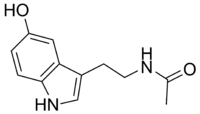N-acetylserotonin
 |
|
 |
|
| Names | |
|---|---|
|
Preferred IUPAC name
N-[2-(5-Hydroxy-1H-indol-3-yl)ethyl]acetamide
|
|
| Other names
N-Acetyl-5-hydroxytryptamine
N-Acetyl-5-HT |
|
| Identifiers | |
|
1210-83-9 |
|
| 3D model (Jmol) | Interactive image |
| ChEBI |
CHEBI:17697 |
| ChEMBL |
ChEMBL33103 |
| ChemSpider |
879 |
| ECHA InfoCard | 100.013.560 |
| 5451 | |
| MeSH | N-Acetylserotonin N-Acetylserotonin |
| PubChem | 903 |
|
|
|
|
| Properties | |
| C12H14N2O2 | |
| Molar mass | 218.252 g/mol |
| Density | 1.268 g/mL |
|
Except where otherwise noted, data are given for materials in their standard state (at 25 °C [77 °F], 100 kPa).
|
|
|
|
|
| Infobox references | |
N-Acetylserotonin (NAS), also known as normelatonin, is a naturally occurring chemical intermediate in the endogenous production of melatonin from serotonin. It is produced from serotonin by the enzyme aralkylamine N-acetyltransferase (AANAT) and is converted to melatonin by acetylserotonin O-methyltransferase (ASMT). Like melatonin, NAS is an agonist at the melatonin receptors MT1, MT2, and MT3, and may be considered to be a neurotransmitter. In addition, NAS is distributed in some areas of the brain where serotonin and melatonin are not, suggesting that it may have unique central duties of its own instead of merely functioning as a precursor in the synthesis of melatonin. NAS is able to penetrate the blood–brain barrier, unlike serotonin. NAS is known to have anti-depressant, neurotrophic and cognition-enhancing effects and has been proposed to be a target for the treatment of aging-associated cognitive decline and depression
NAS may play a role in the antidepressant effects of selective serotonin reuptake inhibitors (SSRIs) and monoamine oxidase inhibitors (MAOIs). The SSRI fluoxetine and the MAO-A inhibitor clorgyline upregulate AANAT indirectly through serotonergic mechanisms and thereby increase NAS levels after chronic administration, and this correlates with the onset of their antidepressant effects. Furthermore, light exposure inhibits the synthesis of NAS and reduces the antidepressant effects of MAOIs. In addition, AANAT knockout mice display significantly greater immobility times versus control mice in animal models of depression. These data support a potential role for NAS in mood regulation and in antidepressant-induced therapeutic benefits.
...
Wikipedia
